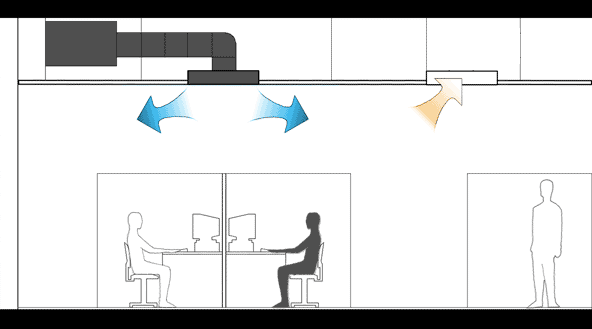| |
 |
|
|
VENTILATION BY DIFFUSION
Ventilation by diffusion involves the injection of
one or several air jets outside the occupied
zone. The jet absorbs large amounts of indoor
air and the velocity gradually decreases. The
occupied zone lies in the return flow and the
velocity here is about 0.7 times the final
velocity of the jet. In practice, there is often a
combination of the aforementioned conditions.
|
 |
Coanda effect
If an supply valve is installed sufficiently near a surface,
the air jet will cling to the surface. Air between the surface
and the jet is carried along, and since new air cannot flow
from above, a slight under-pressure occurs at the surface
and the jet is subjected to an upward motion. For the jet
to cling to the surface, must not exceed 30 cm. |
 |
| Historically, the approach to HVAC design in
commercial buildings has been to supply conditioned air through
extensive duct networks to an array of diffusers spaced evenly
in the ceiling. As shown in Figure conditioned air is both
supplied and returned at ceiling level. Ceiling plenums are
typically quite large to accommodate the large supply ducts
that must fit through them. Return air is most commonly configured
as an un-ducted ceiling plenum return. Often referred to as
mixing-type air distribution, conventional HVAC systems are
designed to promote complete mixing of supply air with room
air, thereby maintaining the entire volume of air in the space
(floor-to-ceiling) at the desired setpoint temperature and
ensuring that an adequate supply of fresh outside air is delivered
to the building occupants. This control strategy provides
no opportunity to accommodate different thermal preferences
among the building occupants or to provide preferential ventilation
in the occupied zone |
|
|
|
|
|
|
|

